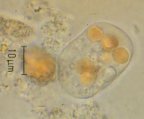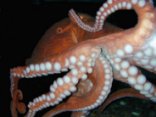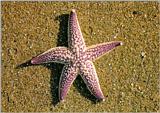The Animal Kingdom
Hello students. My name is Razzmatazz and today I will be teaching
you all about the animal kingdom.
What is an animal? As a general rule, animals can move, unlike
plants that are held in one place by their roots. Animals are not able
to make their own food. They must eat plants or other animals to
survive. Some live on dry land, others on water. Some have two legs,
four legs, six legs or even hundreds.
Animals with similar body characteristics are grouped together in
different categories. There are two main groups of animals;
vertebrates and invertebrates. Vertebrates have a backbone, but
invertebrates do not. Ninety-six percent of all animals are
invertebrates. Here are some examples of different types of animals.
Invertebrates
Protozoans: These are single celled organisms that move by
floating or waving hair-like organs located on their bodies. An amoeba
is a type of protozoan.

Porifera: They are the most primitive of all multi-cellular
animals. They live in fresh or salt water. They can make their own
food but are unable to move from place to place. Sponges are an
example of this group.

Annelids: They have soft flat bodies. Worms that have long
bodies made up of segments are annelids. They have soft bodies with no
hard skeletons. Examples are earthworms, leeches and lugworms.
Mollusks: Soft bodied animals that live in hard shells. They
include such animals as clams, snails, and octopus.

Arthropods: This is the largest group of invertebrates. They
have segmented bodies supported by a hard external skeleton. They are
millipedes, centipedes, spiders, lobsters and crabs.

Echinoderms: These animals live in seawater and have
external skeletons. Examples are starfish and sea urchins.

Platyhelminthes: They have soft, thin, flat bodies. Most
live as parasites in other animals. They include tapeworms and flukes.

Insects: There are about one million known types of insects
and probably another million we have not identified yet. Insects
comprise 80% of all known animals. Some examples are bees, hornets,
grasshoppers, dragonflies and ants.

Vertebrates
Fish: Now stop smacking your lips and listen. Fish first
appeared in the oceans about 540 million years ago. They are able to
breathe underwater by using their gills. Some fish can live in both
fresh and salt water, but most fish; about 60% live in salt water. The
giant catfish is the largest freshwater fish. They can be as big as 18
feet. The largest of all fish is the whale shark, a whopping 60 feet
in length with a weight of 15 tons. The smallest fish is the dwarf
goby that lives in the Pacific Ocean. They are only about 0.3 inches
long.

Amphibians: These are relatively small group of cold-blooded
vertebrate animals and include over 3000 species. Many of them are
water creatures. Others live on land, in trees and in deserts. Most
need water to survive, such as a river, a pond or a droplet on a leaf
to lay their eggs. Several types of amphibians are frogs, toads, newts
and salamanders.

Reptiles: These cold-blooded animals breath with their
lungs, have scales and most lay eggs. They include lizards, turtles
and alligators.

Birds: These animals are warm-blooded, lay eggs and have
feathers and wings. Most are able to fly. Owls, parrots, and robins
are all birds.

Mammals: These are warm-blooded animals that feed their
young with mother's milk. Most are born live from the mother and have
body hair or fur. Dogs, cats, whales, humans and bats are all mammals.

That's the end of the class for today, students. Thanks for taking the
class with me. Good luck on the
exam.













